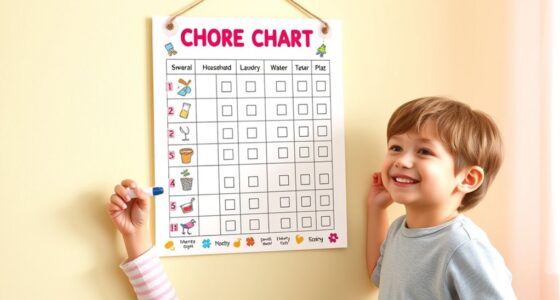To decode tantrums, you should recognize five common triggers: when your child feels overwhelmed or insecure, they often show emotional cues like clinging, silence, or clenched fists. Communication barriers can make tantrums seem sudden since they can’t fully express their needs. As a parent, paying close attention to these signals allows you to respond with empathy, soothing their frustrations. If you’re curious about how to identify each trigger more precisely, you’ll find helpful insights ahead.
Key Takeaways
- Tantrums often signal unmet needs or feelings of frustration, fear, or exhaustion that children can’t verbalize yet.
- Clinging, silence, or physical cues like clenched fists reveal underlying emotional states prompting tantrums.
- Communication barriers cause children to resort to tantrums when unable to express themselves effectively.
- Parents should observe early emotional cues and respond with reassurance and validation to soothe their child.
- Understanding developmental stages helps interpret tantrum triggers accurately and fosters healthier emotional regulation.

Have you ever wondered what your child’s tantrums really mean? These intense outbursts can be confusing and frustrating, but understanding the underlying reasons can help you respond more effectively. Often, tantrums are not just random fits of rage; they are your child’s way of expressing feelings they haven’t yet learned to communicate verbally. By paying attention to emotional cues, you can start to decipher what’s really going on beneath the surface. For example, a child’s clenched fists, crying, or stomping might indicate frustration, fear, or even exhaustion. Recognizing these emotional cues allows you to see their tantrums as signals rather than just disruptive behaviors.
However, emotional cues alone are not enough, because communication barriers often complicate matters. Young children haven’t developed the full language skills needed to articulate their needs or feelings clearly. When they’re overwhelmed or upset, they might resort to tantrums because they lack the words to explain what’s wrong. This creates a gap between what they want to express and what they can communicate, leading to frustration for both of you. The inability to express themselves can make tantrums appear sudden or inexplicable, but they’re really a desperate attempt to bridge that communication gap.
As a parent, your role is to become a keen observer of these cues and recognize the signs early. For instance, if you notice your child clinging to a favorite toy or becoming unusually quiet before a tantrum, it might be a sign they’re feeling insecure or overwhelmed. When you see these emotional cues, you can intervene with gentle reassurance or help them put their feelings into words, like saying, “It looks like you’re upset because you can’t find your toy.” This helps reduce the communication barrier, giving your child a clearer way to express themselves. Additionally, understanding developmental stages and emotional cues can guide you in responding more empathetically and effectively.
Frequently Asked Questions
How Can I Prevent Tantrums Before They Start?
You can prevent tantrums by promoting emotional regulation and practicing proactive discipline. Keep your child’s routine consistent, so they feel secure and know what to expect. Recognize signs of frustration early and redirect their attention or offer calming activities. Encourage open communication about feelings, helping them develop emotional regulation skills. By setting clear boundaries and staying calm yourself, you create a positive environment that reduces the likelihood of tantrums before they even start.
Are Tantrums a Sign of Developmental Delays?
You might worry that tantrums are a sign of developmental delays, but often, they’re just your child’s way of battling massive emotions like frustration or exhaustion. Sometimes, they struggle with emotional regulation or sensory sensitivities, making it feel like their tiny minds are overwhelmed by the world. Remember, tantrums are a normal part of development, not necessarily a sign of delays—they’re just your child’s way of learning to handle big feelings.
What Are Quick Calming Techniques During a Tantrum?
During a tantrum, quick calming techniques can help you soothe your child. You can try simple breathing exercises, encouraging your child to take slow, deep breaths to reduce their agitation. Distraction techniques also work well; redirect their attention to a favorite toy or activity. Stay calm yourself, speak softly, and give them space to regain control. These strategies can help de-escalate the tantrum efficiently and calmly.
How Do I Handle Tantrums in Public Settings?
In the age of chivalry, handling tantrums in public can feel formidable. Stay calm and composed, as your parental reactions set the tone. Gently acknowledge your child’s feelings without overreacting, and calmly guide them away from the scene if needed. Maintain a consistent, reassuring approach to reinforce good public behavior. Remember, patience and understanding help you manage tantrums effectively while keeping the situation from escalating.
When Should I Seek Professional Help for Tantrum Issues?
If your child’s tantrums are frequent, intense, or last longer than usual, it’s time to seek professional help. Look for signs like difficulty with emotional regulation or if tantrums interfere with daily activities. A behavioral assessment can identify underlying issues. Don’t hesitate to consult a specialist if you feel overwhelmed or unsure—early intervention can make a big difference in helping your child develop healthy emotional skills.
Conclusion
Understanding your child’s triggers can feel like trying to find a needle in a haystack, but it’s worth the effort. When you recognize these signs, you can tackle tantrums before they spiral out of control. Remember, patience is your best ally—sometimes you just have to weather the storm. Keep your cool and trust that, with time, you’ll see those tricky moments become easier to handle. Hang in there; this too shall pass.










